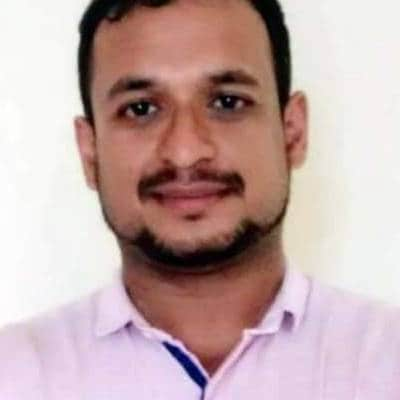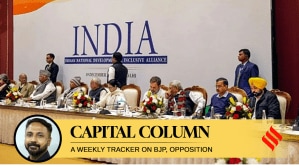Click here to join Express Pune WhatsApp channel and get a curated list of our stories
Sutardara: Pune locality that saw gang war last week was a sleepy hamlet not too long ago
Rise of criminal syndicates in the area is a recent phenomenon dating back to around 15 years
 Sutardara slum, a densely populated slum in Kothrud where gangster Sharad Mohol stayed and was shot dead. (Express photograph by Arul Horizon)
Sutardara slum, a densely populated slum in Kothrud where gangster Sharad Mohol stayed and was shot dead. (Express photograph by Arul Horizon)Sutardara, the densely populated locality off-Paud Road that flashed in the news last week after to the murder of gangster Sharad Mohol in daylight, was a sleepy hamlet about four decades ago.
It was a distant settlement, consisting of a few farmers’ houses, of Kothrud when the latter was a village fairly outside the Pune city.
“About 40 years ago, there were only a few dozen homes in this area. Sutardara was a slum away from the main Kothrud village with only a few houses of the farmers who owned the land in this area,” said Prithveeraj Sutar, Shiv Sena politician from the area whose father Shashikant Sutar is often credited with contributing to the development of Kothrud area.
The area was called Sutardara as most of the land was owned by the Sutar extended family.
 The lane where Mohol was shot dead by assailants. (Express Photograph by Atikh Rashid)
The lane where Mohol was shot dead by assailants. (Express Photograph by Atikh Rashid)
In the last few decades, as Kothrud developed as a posh-suburb with people from the old city areas migrating there partly in the aftermath of the Panshet floods and partly looking to shift to a more spacious locality, areas around Kothrud also slowly became populated.
Poor families from farming communities from Mulshi and Maval area, which lie straight down the Paud Road, who migrated to Pune in search of work started to settle in areas around Kothrud but slightly distant where land rates were much cheaper than those in Kothrud.
“Agriculture in Mulshi taluka had started becoming non-viable which led to the large-scale migration of people to Kothrud and other parts. Areas to the west of Pune such as Sutardara, Kelewadi, Hanuman Nagar and Jai Bhavani Nagar soon become the hub of these migrants who earned a living as labourers or part time labour contractors in Pune,” said a resident who didn’t want to be named.
As per Sutar, the area which was home to only a few families now has a population of around 25,000. About 70 per cent of these are from Mulshi and Maval areas, he estimates.
‘Cheap Kothrud’
This locality lies in the shadow of the posh societies of Kothrud and life here is much cheaper than the one across the Paud Road.
“It’s a cheaper place to stay hence families from other parts of the state and outside also move in here looking for rental accommodation. A large number of students – who study at the numerous educational institutions in the Kothrud area – also stay here in cheaper flats and hostels. Homeowners who have prospered move out to other localities and rent out homes to those looking out for accommodation,” said Sutar.
Not far from where Mohol stayed, we found 50-year-old manual labourer Subhad Bhogad who had migrated to Pune from coastal Ratnagiri with his family ten years ago and moved in a one-room tenement in Sutardara.
“I have a rent of Rs 3,500. It’s affordable for me although the house is too small for us. I am looking for a better place,” said Bhogad. He said that he was at home on the day the gangster Sharad Mohol was shot dead.
“Sometimes we have Koyta gangs on the streets and other times youngsters create ruckus after getting drunk. But it happens among the gangs. I have no reason to fear,” he says.
The lanes in the densely populated area are quite narrow and the families that own four-wheelers must park them at open forest department land outside the locality. Motorbikes parked on both sides of the lanes make them narrower. Every once in a while, there are reports about locals complaining of the bad drainage system, low-pressure water supply and unavailability of garbage collection systems.
The main narrow lane, which now has been seen by thousands through the circulation of the footage of the assault, connects the Vitthal Rukmini Temple with the southern end of the locality. It has only one CCTV camera installed and under its clear purview the daylight shooting happened.
Many believe the spot was deliberately chosen by the assailants assuming that the retrieval and circulation of the footage of the assault will add to their infamy.
“Since the population of the area has grown manifold in the last two decades, the resources are understandably under pressure. A place which was supposed to house a few hundred he now home to about 25,000. That will put the resources and amenities under destress,” says Sutar.
‘Gangs and gangwars’
The rise of crime and criminal syndicates in the area is a much recent phenomenon and dates back to around 10-15 years. As per locals, the genesis of this was the rising land rates in and around Pune which saw many of the erstwhile farmers becoming millionaires overnight.
“Mulshi soon became the hub of land grabbers and many of them operated their syndicates from outside the area. Sutardara became one of the centres given the strong ties the families had with themselves, “the resident said.
Given the apparent glamour, the so-called criminal elements exhibited — flashy cars, gold jewellery — the younger members of the area were drawn to such gangs.
Over the years the minimum age of the recruits have come down with many of them joining the gangs even in their late teens.
One such young man, Sahil alias Munna Polekar who stays in one of the narrow lanes with his mother and younger sister, stirred the plot last week when he – along with some accomplices – shot dead one of the most dreaded residents of Sutardara.
Click here to join Express Pune WhatsApp channel and get a curated list of our stories













